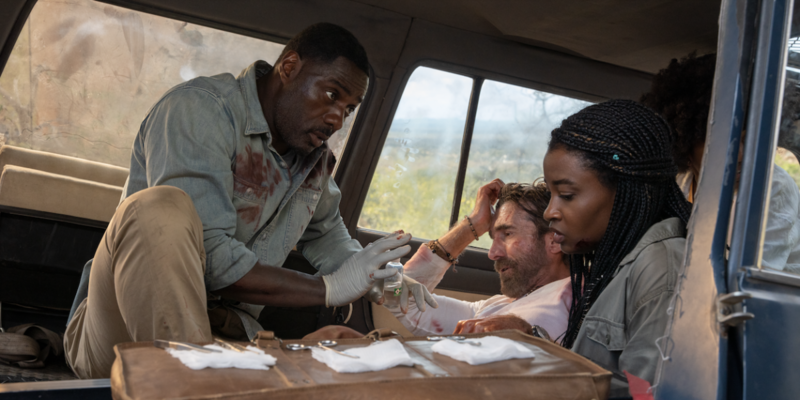
Review by
Eric Hillis
Directed by: Baltasar Kormákur
Starring: Idris Elba, Sharlto Copley, Iyana Halley, Leah Sava Jeffries

With movies like
The Deep,
Everest
and Adrift under his belt in recent years, Icelandic
director Baltasar Kormákur seems to have become the go-to guy for
true stories of people surviving against nature and the elements. His
latest, Beast, is another survival thriller, but it's as detached from reality as
you could imagine. An entry in the "Animal Attacks" sub-genre,
Beast is the sort of movie that usually now goes straight
to VOD with Nicolas Cage or Megan Fox in the lead, so it feels odd to
watch its man vs nature antics play out on a cinema screen. There was a
time when cinemas were filled with these movies. That time was in the
years following the success of Jaws, when Hollywood, and often Italy, was churning out thrillers featuring
people getting chewed and clawed by every creature that made its way
onto Noah's ark.
A checklist of clichés quickly emerged in the sub-genre, and much of the
fun of those movies came in seeing how filmmakers would apply such
stereotypes. Beast has some of the clichés we expect from
a movie of its type, but it's sorely missing one of the most important
tropes of the Animal Attacks movie – the Asshole. The Asshole is the
character who is so unlikable the audience actively roots for their
comeuppance, and any Animal Attacks movie worth its salt will have a
final act payoff where said character is subjected to a particularly
brutal onscreen death at the hands, or rather paws, of the animal
antagonist. My personal favourite Asshole is the one played by a wildly
over-the-top Leslie Neilsen in William Girdler's
Day of the Animals, which along with the same director's Grizzly, is arguably the best of the Jaws cash-ins.

Sharlto Copley is in Beast, and once you see his name in the credits you immediately assume he's
the Asshole. But no, contrary to most of the characters the South
African star has played recently, here Copley is a thoroughly nice guy.
He's Martin, a park ranger in a South African reserve populated by
several lion prides. He describes himself as an "enforcer", hinting that
he's had to take violent action against the poachers who have been
killing the local lions. We see a group of such poachers gun down a
pride in the film's surprisingly gruesome prologue, where one male lion
escapes to embark on the rampage that will fuel the movie's
narrative.
Finding themselves on the lion's potential dinner plate are visiting
American doctor Nate (Idris Elba) and his daughters Meredith (Iyana Halley) and her little sister Norah (Leah Sava Jeffries). Movies like
this often adopt the cliché of the estranged couple who bond over the
course of their ordeal. Here this is given a twist, with Nate struggling
in his relationship with his girls. Just before she succumbed to a fatal
illness, Nate walked out on their South African born mother, and
Meredith in particular has been making her old man feel guilty ever
since. This subplot feels obligatory rather than natural, and it's often
brought up at the most inopportune moments.

Much of the movie sees Nate and his kids trapped in a jeep ala
Cujo, as the angry lion lurks outside. Martin suggests that, like the shark
in Jaws IV: The Revenge, this lion holds a personal grudge against humans over the death of
his family. It's a throwaway line that plunges what has up to that point
been a relatively grounded film into the realm of schlock, but
Beast never gets as schlocky as it really needs to be.
It's a film that's shockingly grim in parts, with Kormákur's camera
lingering over the torn apart corpses of native women (one of whom is
pregnant, just to make it that bit nastier) and children, so whenever
the sillier elements enter the picture they're particularly
jarring.
Kormákur struggles to mine tension from what should be a nail-biting
scenario. We never feel like Nate and his girls are in any real peril as
they keep leaving the safety of the jeep to go wandering off for some
contrived reason or another, and the lion doesn't seem all that bothered
about taking advantage of their devil may care attitude. Kormákur makes
heavy use of a steadicam, with most of the movie's scenes playing out in
long unbroken takes. I imagine the intention is to dazzle us with
technique, but it just results in the camera spending too much time
following the protagonists rather than establishing their environment.
This makes it difficult to get a geographical grasp of where the
characters and the lion are in physical relation to one another at any
given point. The CG lion is relatively convincing in wide shots but in
close-ups it's a little too reminiscent of the recent Lion King remake.
The more we see of it the more artificial, and thus less threatening, it
becomes.

Making the central family African-American doesn't paint over the
queasiness of being asked to care about middle class Western
protagonists while disposable natives are being ripped to shreds in the
background. We've seen Elba perform with a South African accent in the
past, so I'm not sure why his character couldn't have been a native of
the country rather than a wealthy foreigner. Ditto the closest the film
has to human villains in a group of poachers. Sure, poaching is horrible
but it's often done by desperate people who have no other way of feeding
their families, so we can't enjoy watching the poachers get what the
film sees as their comeuppance. This could have been easily fixed at the
script stage by changing these characters from native poachers to rich
western hunters, like those American dentists who hang photos of
themselves standing over an animal corpse in their surgery waiting
rooms. Now that's what I call an Asshole.


